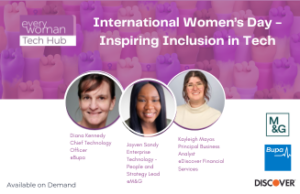A lack of diversity in the tech industry is far from a new problem, and while change is happening, it’s at glacial pace. Recent estimates suggest that roughly 29% of today’s tech workforce is made up of women — an increase from 26% in 2019. But if change continues at this rate, it could take 12 years before women see equal representation.
Everyone deserves to work in an environment where they feel valued and supported, plus we all know by now that a more diverse workforce means a more successful business. So the onus is on everyone to fight for one.
One way of doing this is to be an ally to women in tech. For practical tips on how, read on…
1. Connect with other women to see where you can help them
‘I find it’s easy to be an ally for women in tech if you allow yourself to understand the discrepancies between how the genders are treated,’ says Jen Kaarlo, digital content strategist. ‘Having one-to-ones with your female colleagues is a good starting point… ask lots of questions, and see what issues they may be facing both in and out of the workspace. If you can better understand what some of the concerns are, it helps create new protocols and initiatives within the greater company structure.’
Events are great networking opportunities, which is something women often lack, so look into holding these within your organisation. Female-led events that disseminate the benefit of gender equality are ideal places to start, says Kaarlo, as well as peer panels and discussion days.
Mentoring, either informally or as part of a workplace scheme, is a great way to offer hands-on support to women in tech. (And if your workplace doesn’t have one in place, why not suggest the idea?) And don’t forget the potential impact of reverse mentoring — partnering up with a junior colleague to see what you can learn from them.
2. Look at initiatives that offer broader support to women
There are a whole range of initiatives out there working to create a more inclusive tech industry, such as GirlsWhoCode, TechUp and WomenWhoCode. Does your workplace sponsor or partner with any such companies or initiatives? If not, perhaps you can lead the charge in changing this.
Depending on the size of your company, you could also look at the potential for implementing an internal initiative to develop female talent. PwC for instance, runs the Women in Technology initiative, which helps women at all stages, from inspiring students to pursue a tech career to helping women navigate the menopause in the workplace.
3. Lobby for fairer policies in order to foster inclusivity
A growing archive of research has shown categorically that having gender-equal programmes and policies in place, such as maternity/paternity packages, leads to greater hiring, retention, advancement and general representation of women in tech.
And while there are costs involved in creating, for instance, a generous and gender-equal parental leave policy, as ZestFinance’s chief people officer, Sonya Merrill points out, these costs are compensated for further down the line. ‘The important question really is: “What’s the cost of not offering these extended benefits?”…When we looked at our options, we realised that by not extending our family leave programme, we would run the risk of losing great talent and potentially making it difficult to attract new, family-minded, and diverse people.’
What do your company’s maternity/paternity and flexitime policies look like? If they’re not gender equal, make your voice heard in trying to change this.
4. Speak out against micro-aggressions and challenge the status quo
When you witness discriminative or unethical behaviour towards women or any other minority group, it’s not enough to privately condemn it. To be an ally you need to speak up — to challenge bias, discrimination and unethical behaviour to create a more inclusive society. This can take the form of anything from calling out when someone gets talked over during a meeting, to confronting bias or discriminative language, and is the theme of 2021’s International Women’s Day (#ChooseToChallenge).
If the idea of taking action makes you feel uncomfortable, try to look at the situation not as a confrontation but, says D&I consultant Vessy Tasheva, ‘as an opportunity to provide the person or people affected with stability, compassion and a sense of hope. For example, we can approach the team lead of the person affected and share our concerns with them. Ideally they will be more comfortable with confrontation than us, and more influential in the organisation.’
5. Arm yourself with knowledge to make gender equality part of your brand
To be an effective ally you need to know why you are taking a stand, so arm yourself with the latest statistics, such as 29.8% of board members are women, with just 6.6% of these being women of colour.* And share research wherever most appropriate, be that via your social media platforms or through workplace conversations — make allyship part of your personal identity.
There may also be times where you need to convince others of the need to prioritise D&I. Former everywoman Male Agent of Change winner, Jim Bichard, says, ‘You have to appeal to different people and their motivations. In our case, we’re a talent business — our clients rely on us to have the best people, so D&I is a business imperative. If I can find a way of retaining, attracting and developing more talented people, we’re going to be more successful. And walk the talk — don’t tell others to make changes you wouldn’t be prepared to.’
6. Listen critically and call out approaches that don’t work
In her piece for Quora, Lucy Sanders, CEO and co-founder of the National Center for Women & Information Technology, highlights how important it is to recognise ineffective approaches to diversity issues. ‘Avoid approaches that focus on ‘helping’ or sometimes even ‘fixing’ individual women. These approaches are not research-based and can come across as patronising,’ she says.
So, for instance, the idea that women ‘lack confidence’ gets bandied around frequently, but is problematic as it puts the blame on women. Rather, the focus should be on why certain environments may make women may feel less able to speak up. The Critical Listening Guide is a great place to start to better understand common misunderstandings.
Hear from key industry experts and how they reached the top in our 2021 everywoman in Tech Forum. Our Forum is taking place online from March 16th to the 18th. As a Tech Hub member, you get a 10% discount. Get your discount and register today!



